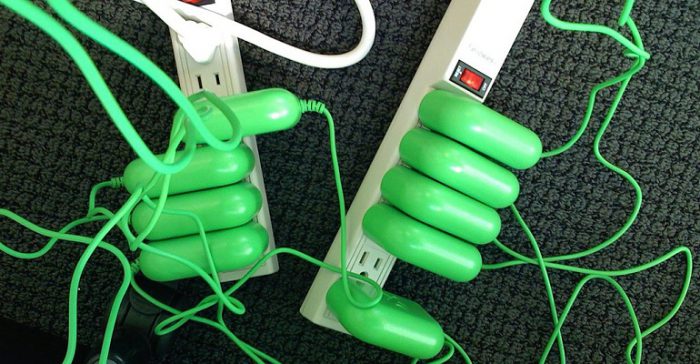DOE’s New Power Supply Standards Are a Big Win for Consumers and the Environment
Appliance Standards Awareness Project, February 3, 2016. Image credit: Mike Lee
Thanks to a new national standard announced today by the U.S. Department of Energy (DOE), power adapters–the sometimes bulky and annoying boxes on the power cords of your electronic gadgets–will waste a lot less energy. Just as importantly, DOE deferred new national standards for battery chargers, allowing strong existing standards in California and Oregon to remain in place.
External Power Supplies
Laptop computers, tablets, cell phones, cordless phones, digital picture frames, modems, routers, computer speakers, printers and countless others devices need power adapters, also known as external power supplies (EPSs), to convert household electric current (120 volts in the U.S.) to the lower voltages at which those devices are designed to operate. Unbeknownst to many, these adapters unobtrusively consume significantly more energy than necessary to do their job.
The new power supply standard, which will take effect in two years, is an update to a standard first adopted by California, and enacted nationally as part of the Energy Independence and Security Act of 2007 (EISA). The original standard eliminated the least-efficient types of power supplies for most products, doing away with many of the brick-like units which were often warm to the touch (that heat was energy waste) and which annoyed many of us by blocking neighboring power outlets with their bulk. The result was less wasteful and less annoying products.
The latest DOE standards strengthen the efficiency requirements for previously covered units, and extend the standards to include several other EPS types. They will also cut adapter energy use by 30 to 85% depending on the device. Based on ASAP’s analysis of DOE’s published data, the savings will add up to about 30 kilowatt-hours (kWh) a year for a typical household once all adapters in the home comply.
While the savings per household may seem modest, they add up quickly on a national level. DOE estimates current annual shipments of about 345 million EPS units (and growing), and the new standards will affect 75-80% of those sales. According to DOE, over thirty years of sales, the new standards will save 93 billion kWh and reduce power plant CO2 emissions by 47 million metric tons, an amount about equal to the annual emissions of 10 million cars. Net consumer savings will amount to about $3.8 billion.

